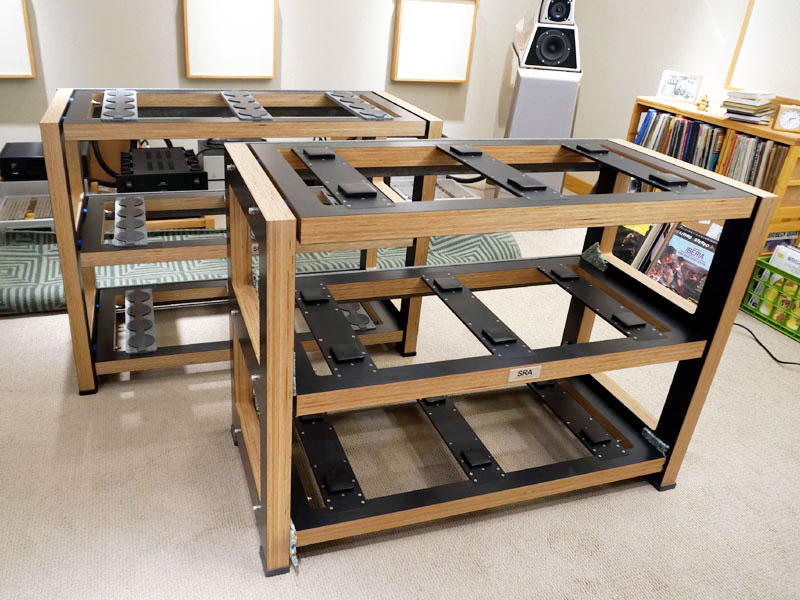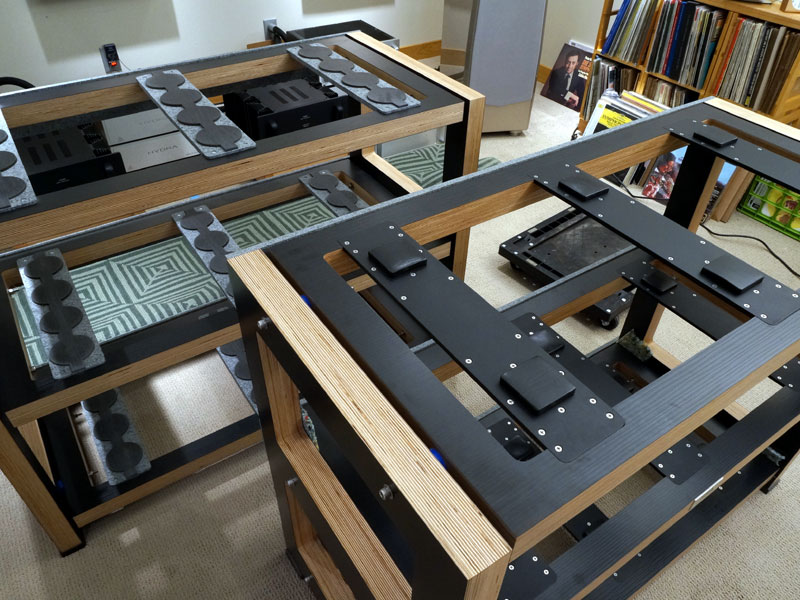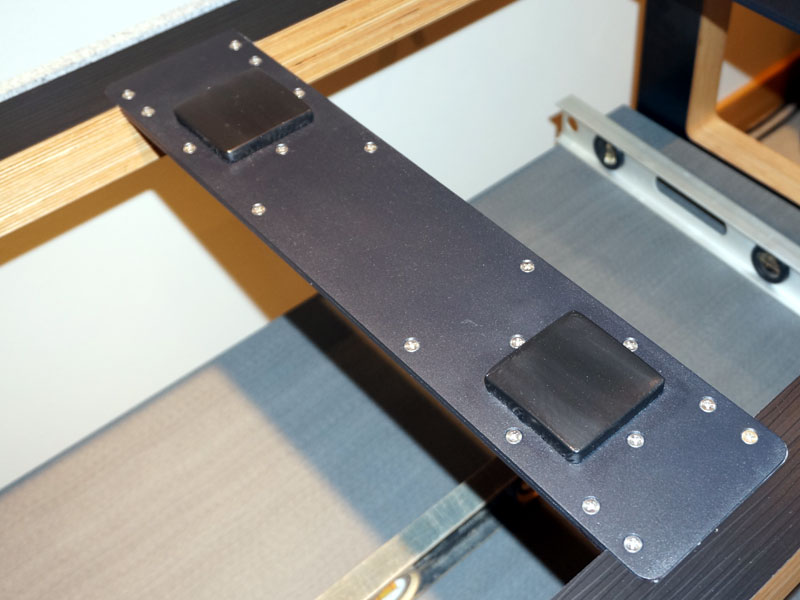First Sounds: Silent Running Audio Scuttle³
t came as a surprise when Silent Running Audio’s CEO Kevin Tellekamp offered me the prospect of evaluating the third-generation Scuttle equipment rack. The Scuttle I purchased in 2011 was one of the very first of its kind to leave the factory, so I jumped at the opportunity to discover what had been wrought in the intervening years. From the outset "the goal for the Scuttle was a simple one," said Tellekamp: "performance like Craz, but much less expensive." In the event you haven’t heard of it, the Craz ³ is SRA’s top-of-the-line audio rack. It features a titanium endo-skeleton precision joined with a furniture-quality maple outer frame. Using proprietary vibration-abatement materials derived from SRA work in the industrial, defense and medical industries, each Craz is computer-modeled and hand-built specifically for the components it will support. As befits its handmade quality, the Craz³ comes at a reference-component price starting at $12,000 and progressing based on width and number of shelves.
As SRA continued its research, their materials science evolved. And Tellekamp never lost sight of his goal: as the Craz improved, so did the Scuttle. The evolution from Scuttle to Scuttle ³ ($9700 for a double-wide, three-tier rack) passes through Scuttle², a model still in production. After two years of R&D into materials processing, SRA produced a new lab-born, created-from-scratch shelving material for use on the Craz rack that was so effective they decided to use it on Scuttle. Thus, Scuttle² was born. These upgraded Scuttle Iso-Shelves are 33% thicker than the original and feature crisp, square edges versus the rounded edges of the early shelves. The Scuttle³ contains all of the changes and upgrades found in Scuttle². To go beyond the Scuttle², however, SRA took its most significant steps yet toward delivering Craz-type performance at a much lower cost.As described by SRA Scuttle maven Tim Miller, the new Iso-Shelf material "is comprised of soft spherical nanoparticles, all existing in an irregular void matrix, within tiny vacuum pockets." Vibrations on a shelf tend to gain speed and complexity as they move across it. The Iso-Shelf acts like an array of "nets," causing vibrational energy to use itself up as it attempts to proceed. Certain sizes of vibrations that slip through one net encounter succeedingly smaller and smaller nets. Miller makes the analogy to a runner who burns up energy as he encounters increasingly deeper and softer sand. He describes the shelves as "living" because the soft Iso-Shelf material inhales vibration across its surface and exhales its energy as low-grade heat. The benefits of the new material far outweigh its one downside: fingerprints. As I discovered, pressing your hand on a shelf will leave a mark. Not to worry -- the shelves clean up easily with a cloth and mild household cleaner or isopropyl alcohol. To support the new shelves, the Scuttle ³’s vertical and horizontal frame members are 5mm thicker than those of my original model. These are built up from hardwood and softwood layers as well as laminate, and bonded with viscoelastic glue, then milled on a CNC router. Viscoelastic-materials development is an SRA specialty, and they even improved the glue since the first Scuttle. A black phenolic resin covers two sides of each frame piece and brings added strength. SRA mills the resin in a specific wavy pattern designed to slow vibration’s travel on the chassis’s surface. (A "Blacked-Out" Scuttle is available that coats the entire frame with the resin.) The unit’s feet use the new vibration-consuming material found in the Iso-Shelves.At the heart of SRA’s Craz rack and its top-performing component platforms (such as its Ohio Class and Virginia Class units) is a design process the company calls Component Specific Design (CSD). As the name implies, CSD allows SRA to build platforms for the exact audio equipment they will carry, in the exact placement they will have on the rack and in the room. Like a fingerprint, every audio component has a unique resonance-frequency potential -- SRA calls it "gear-print" -- determined by a piece’s size, weight, weight spread, resonance frequencies, transmission curves, propagation responses, and other material and vibrational characteristics. When a component changes, even in a simple way, such as a new face plate or new feet, so does its gear-print. To build a platform or rack for the specific equipment it will carry, SRA feeds detailed data about each component’s characteristics into their computer modeling system. Proprietary algorithms yield a description of the problems to solve and the parameters for solving them. Through this process SRA knows the exact materials and construction necessary for a bespoke solution before construction begins. Component Specific Design is a complex and costly endeavor, but it is one of the ways SRA believes they differentiate their products from generic, one-size-fits-all isolation devices.
For the original Scuttle and Scuttle², SRA took a problem-averaging approach based on percentages that targeted the most common vibrational challenges found in a typical high-end audio system. Unlike those earlier models, Scuttle ³ is designed like a Craz rack, using CSD. To implement the specific custom gear-print tuning requirements coming out of CSD modeling, SRA replaced the earlier Scuttle’s rounded isolator pads (mounted to supports on each shelf’s frame) with the custom IsoPODS used for the Craz. An IsoPOD contains proprietary SRA-developed material capable of near-instantaneous adaptation to shifting vibrational load. The CSD process identifies the specification for each IsoPOD on each shelf. The IsoPODs mount onto Craz-like metal crossbeams, which variably flex under vibration. SRA calls the crossbeam the unit’s Mass-Load-Support-System (MLSS). As called for by CSD modeling, the beams are cut to varying thickness from military-grade aluminum and treated or hard-coated. Three MLSS beams, each carrying two IsoPODS, support one shelf on a double-wide Scuttle³.Unlike prior Scuttles, the shelves of version 3 enjoy the same six degrees of freedom (6DOF) found in the rest of the rack. When I touched a shelf with my finger, it moved, and each shelf on the rack responded independently of the others. SRA designed all components in a Scuttle ³ -- the feet, the frame, the IsoPODs, MLSS and Iso-Shelves -- to function together, making the entire rack a sophisticated constrained-layer damping system. According to SRA, Scuttle³ doubles the isolation potential of the original -- very impressive and very Craz-like.
The IsoPODs and MLSS crossbeams, like the rest of the components of the Scuttle ³, have a lifetime warranty. Actually it’s better than that, because the Scuttle³ accrues the same benefit afforded a Craz owner. If you change a component, or even its position on the rack, SRA will send you the IsoPOD/MLSS combination(s) appropriate to the gear-print of your new setup. It’s an easy swap that requires only a screwdriver to complete; just send back the old parts. And SRA did not forget about their Scuttle² users. By purchasing IsoPODS and MLSS beams, each Scuttle² can be owner-upgraded to full Scuttle³ status, either all at once or one shelf at a time, as need and finances dictate. You can order a new Scuttle² with a mix of shelves; for example the top shelf used for a turntable could be at the Scuttle³ level. SRA will even take an original (non-upgradeable) Scuttle in trade toward a new Scuttle³.A standard double-wide Scuttle ³ like my original rack has three shelves to hold six components and measures 36"H x 47.5"L x 22"D. A single-wide model ($9060) holding three components is 36"H x 30"L x 22"D. Both offer 12" usable space between each of the lower two shelves. Two-shelf units and custom sizes are also available.The sonic influences I ascribed to the first Scuttle in my review held true for the Scuttle ³, but its further improvements were immediately audible. The Scuttle³ brought a greater reduction in distortion and an even lower noise floor. In my system, this meant an overall increase in clarity across the music’s entire frequency spectrum. A decrease in temporal smearing let me hear deeply into complex orchestral works while bringing greater definition to individual instruments and sections and greater soundstage depth to the entire orchestra.Consider the piccolo solo in the Third Movement of Tchaikovsky’s Symphony No.4 (LP, Maazel and Cleveland [Telarc 100047]). It demands that the musician deliver 21 notes in barely three seconds. This may be the most difficult passage in all of piccolodom, and at fortissimo dynamics, the high-pitched solo rides above the full orchestra. It’s difficult to play well without sounding shrill. With the Scuttle ³ in place, I heard each note exactly articulated from start to finish and, more impressively (having sat next to piccolo players), as natural in pitch, timbre and emphasis as I have ever heard from my system.On the delightful Decca recording of a young Maazel conducting Sibelius’s 1st Symphony (LP, VPO [Decca SXL 6084] the reduction in component vibration achieved by the Scuttle ³ helped me gain a new appreciation for the wonderful layers and layers of articulated bass foundation Sibelius wrote for cellos and double basses, tuba and horns. With less smearing and newly heard timbral complexity, the hand-off of musical lines from section to section in the lower frequencies became obvious.Above all, with every record I played, music gained a greater feeling of fluidity, ease and natural vivacity. The Scuttle ³ reduced previously unnoticed perceptions of electromechanical reproduction -- a haze of artificiality, if you will -- and I found myself more relaxed and enjoying my stereo more. My system sounded better than I thought it was.As I’ve gained more listening experience over the years, I am convinced that audio-room infrastructure (clean power on demand, proper acoustics and vibration isolation) is as critical to getting lifelike music from your audio system as any component you can buy. In the case of the SRA Scuttle ³, it was as if each component mounted on it received an upgrade. In reality, I was hearing my stereo closer to its designers’ intent, getting more of the value I paid for. If you’ve never had a Scuttle in your system -- built for your components -- adding one will take you on a joyful journey of rediscovery through your music collection. |



